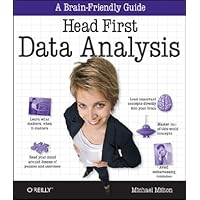
Average Reviews:

(More customer reviews)This book is for professionals that must analyze data in their daily work. First off, if you are unfamiliar with the approach of the "Head First" series of books by O'Reilly, the approach was and is revolutionary in the field of technical writing. The authors of this series know that page after page of terse text will not easily penetrate the brain of the working professional who needs help rather quickly. Traditional textbook models work best on students in a traditional classroom setting who can slowly absorb material over a period of several months with the help of bi-weekly classroom sessions with a professor. The working professional does not have this luxury of time or of personal tutoring.
Thus the authors both penetrate your brain and hold your interest by serving information up in unusual ways - odd pictures and illustrations, Q&A sessions, repeating the same material in different ways, and interesting case studies in which you are asked at every step to give your input. They'll even lead you down the the wrong path every now and then so that you remember the right one all the better.
As for the subject matter, this is not a book on statistics and how to solve problems in statistics. Instead, it is how you use various statistical models and tools and visualization to analyze often confusing corporate data and come up with recommendations based on that data. Some mathematical methods will be presented as they are necessary to solving the underlying problems - optimization, hypothesis testing, bayesian statistics, subjective probabilities, heuristics, and histograms - these are all mentioned and even have their own chapters. However, this book is also about tools - R and the analysis tools of Excel specifically. In the appendix, this book even shows you how to install R.
However, I don't believe that you could get away with knowing nothing of statistics and really get the most out of this book. If you do happen to have the luxury of a little time I suggest the following. Read the excellent Head First Statistics as a tutorial, and then use the problems in Schaum's Outline of Statistics (Schaum's Outline Series) to test your knowledge. Then you should be more than ready for this book.
The author has a chapter entitled "leftovers" that tells you what this book does not cover. I include that here so that you don't waste your time if this is what you are looking for:
1 Everything else in statistics
2 Excel skills - (book assumes previous experience)
3 Edward Tufte and his principles of visualization
4 PivotTables
5 Nonlinear and multiple regression
7 Null-alternative hypothesis testing
8 Randomness
9 Google Docs
I highly recommend this book for the right audience with the right experience level.
Click Here to see more reviews about: Head First Data Analysis: A Learner's Guide to Big Numbers, Statistics, and Good Decisions
Today, interpreting data is a critical decision-making factor for businesses and organizations. If your job requires you to manage and analyze all kinds of data, turn to Head First Data Analysis, where you'll quickly learn how to collect and organize data, sort the distractions from the truth, find meaningful patterns, draw conclusions, predict the future, and present your findings to others. Whether you're a product developer researching the market viability of a new product or service, a marketing manager gauging or predicting the effectiveness of a campaign, a salesperson who needs data to support product presentations, or a lone entrepreneur responsible for all of these data-intensive functions and more, the unique approach in Head First Data Analysis is by far the most efficient way to learn what you need to know to convert raw data into a vital business tool. You'll learn how to:
Determine which data sources to use for collecting information
Assess data quality and distinguish signal from noise
Build basic data models to illuminate patterns, and assimilate new information into the models
Cope with ambiguous information
Design experiments to test hypotheses and draw conclusions
Use segmentation to organize your data within discrete market groups
Visualize data distributions to reveal new relationships and persuade others
Predict the future with sampling and probability models
Clean your data to make it useful
Communicate the results of your analysis to your audience
Using the latest research in cognitive science and learning theory to craft a multi-sensory learning experience, Head First Data Analysis uses a visually rich format designed for the way your brain works, not a text-heavy approach that puts you to sleep.

No comments:
Post a Comment